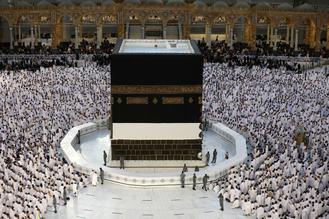 Muslim pilgrims pray around the Kaaba at the Grand Mosque, in Saudi Arabia's holy city of Mecca on July 6, 2022, during the annual Hajj pilgrimage. (CHRISTINA ASSI / AFP)
Muslim pilgrims pray around the Kaaba at the Grand Mosque, in Saudi Arabia's holy city of Mecca on July 6, 2022, during the annual Hajj pilgrimage. (CHRISTINA ASSI / AFP)
Saudi Arabia’s plans for an eco-friendly Hajj will catalyze the green halal tourism industry, experts say.
Two of Islam’s holiest cities, Mecca and Medina, are in Saudi Arabia. Traditionally, millions of Muslims go there for the Umrah, or pilgrimage, and the Hajj, which Muslims need to complete once in their lifetime.
The Saudi Green Building Forum, along with the United Nations Environment Programme, is studying the Al Mashair area to restore the ecosystem and check its carbon capacity
On July 3, the Saudi-based Arab News reported that the Saudi Green Building Forum, along with the United Nations Environment Programme, is studying the Al Mashair area to restore the ecosystem and check its carbon capacity. Al Mashair, it said, covers 119 square kilometers and encompasses the key Hajj sites of Arafat, Muzdalifah and Mina.
Saudi Arabia in March last year unveiled the Saudi Green Initiative and the Middle East Green Initiative – both roadmaps to meet emissions targets, enhance environmental protection and boost efforts toward renewable energy production.
They are part of a grander plan under Saudi Vision 2030, a socioeconomic blueprint that aims to transition the Arab nation’s economy and reduce its reliance on oil.
Salman Zafar, founder of EcoMENA, an environmental think tank in Doha, Qatar, noted that Hajj, one of the largest gatherings of people worldwide, has a huge environmental footprint.
“The transition to an eco-friendly Hajj will have a profound impact on the environment as millions of Hajj pilgrims will be forced to reflect upon their unsustainable lifestyles and reckless attitude toward the environment,” Zafar said.
“A green Hajj will also catalyze the green halal tourism industry in the Middle East as more and more Muslims are looking to travel to those places where the demands of Muslim tourists can be met while protecting nature,” he added.
READ MORE: Muslim pilgrims in Mecca for first post-pandemic hajj
Fatima Ahmed, a board member of the Association of Bahrain Travel and Tour Agents, said as the world gradually moves toward sustainable tourism practices, it is vital to have such green initiatives, which Saudi Arabia addressed in its 2030 vision.
“Green Hajj aims to serve better, preserve the holy sites, reduce wastage and improve air quality. This means (future) generations will inherit an opportunity for better-quality Hajj seasons,” said Ahmed, who is also the owner of Ibn Firmas Travel & Tourism in Bahrain.
Ahmed said such initiatives are also driving the industry to find more innovative ways to promote sustainable tourism.
“Fly less, drive more, and explore,” said Ahmed, referring to travel within the Middle East that will help empower the economies of the region’s neighboring Islamic countries.
July this year was the first time Saudi Arabia had allowed foreign pilgrims to perform the Hajj since the coronavirus outbreak in 2020, as the last two seasons were limited to domestic pilgrims.
The total number of pilgrims in the recently concluded Hajj season reached 899,353, including 779,919 foreign pilgrims and 119,434 domestic ones, according to the Saudi General Authority for Statistics.
Fazal Bahardeen, founder and chief executive of CrescentRating, a research and consultancy firm focused on halal travel, said as the Muslim travel market restarts its growth trajectory after the COVID-19 interruption, Muslims are becoming more conscious of the impact that travel has on the environment.
He said sustainability will become increasingly central in shaping business and consumer decisions in the halal tourism sector.
According to the Mastercard-CrescentRating Global Muslim Travel Index, international Muslim visitor arrivals will reach 230 million by 2028. But the report cautioned that ongoing conflict in Ukraine, rising gasoline prices, and health hazards like the emergence of monkeypox or COVID-19 mutations, “might all thwart this fragile healing process”.
ALSO READ: Greece, Saudi Arabia seal deal on data cable
Bahardeen said Muslims, as globally responsible citizens, need to understand their carbon footprint in tourism – from their choice to travel, their destinations, to their stays and their food consumption. He spoke of tackling over-tourism, and the negative environmental and cultural impacts that travel can have.
“To acknowledge and encourage sustainability initiatives by destinations, GMTI introduced ‘sustainability’ as a ranking criterion in the GMTI 2022 report. We will continue to expand the scope of this ranking metric in future reports. We are also looking at enabling a carbon-offset program with our travel service offerings on Halaltrip,” Bahardeen said.
Zafar of EcoMENA described green halal tourism as “the subsection of halal tourism” and said many Muslims are hesitant to travel to places with “an overdose of Western culture and unsustainable practices”.
He said the transition to an environmentally friendly Hajj will involve legislation and behavioral change among pilgrims. Banning single-use plastics, reducing food waste, conserving electricity, using eco-friendly building materials, providing electric buses and conserving water are some of the measures that “can make the Hajj green in the real sense”.
Xinhua contributed to this report.


